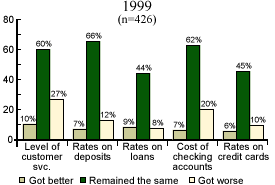GALLUP NEWS SERVICE
According to a February 1999 Gallup poll, more than four out of 10 consumers (43%) have been customers of a financial institution that has been bought, sold or merged with another financial institution during the past two years. Previous Gallup Poll data show that a similar percentage of American consumers have been impacted by bank mergers in each year since 1995.
Historically, consumers are not very likely to switch the financial institutions they use. Unlike switching telephone companies, switching one's bank involves filling out a lot of forms, moving account balances, getting new checks, and dealing with new people. In other words, there are high transaction costs associated with switching financial institutions. This makes it easier for financial institutions to keep their current customers while making it more difficult for them to obtain new customers.
A bank merger, however, often stimulates the consumer to think about the costs of staying with a new institution that has acquired their accounts compared to the costs of moving their banking relationship to another financial institution. In this context, the increased bank merger activity of the last half of the 1990s has given many consumers a potentially new reason for switching banks. As a result, more consumer banking relationships have been up for grabs in the late 1990s than at any time in the last 50 years.
The Impact of Bank Mergers on Consumers
Not surprisingly, most consumers whose bank merged with another say
that things stayed pretty much the same after the merger. In this
context, the merger was essentially a non-event to most
consumers.
Of course, it is customers who say they have experienced a change in their banking relationship due to a merger who are most likely to consider switching banking institutions. The following are true of those in the 1999 survey who said they have experienced a bank merger in the past two years and did see a change:
- Nearly three times as many say that customer service "got
worse" (27%) as say it "got better" (10%);
- Similarly, three times as many also say the cost of checking
accounts "got worse" (20%) as say it "got better" (7%);
- About twice as many say that rates on deposits "got worse"
(12%) as say they "got better" (7%);
- Nearly twice as many also say that rates on credit cards "got
worse" (10%) as say they "got better" (6%); and
- There is little difference between the percentage of those who say that rates on loans "got better" (9%) and the percentage of those who say they "got worse" (8%).

Factors Determining Whether Customers Stay or
Leave
Given the number of customers who say things got worse instead of
better after the merger took place, it should not be surprising
that many consumers leave newly merged institutions. In fact, about
one out of five consumers (21%) who have experienced a merger at an
institution at which they have been a customer say that they
switched to another institution after the merger -- most within six
months of it. Again, previous Gallup poll data indicate that this
has been a consistent trend since 1995.
Also not surprising are the factors customers cite as having a major impact on their decision to switch their financial institution after its acquisition. Consumers say that the newly merged institution they left was:
- more impersonal (66%),
- gave poorer customer service (58%),
- had higher fees (52%),
- took too long to fix a problem (51%),
- charged too many fees (48%), and
- made too many mistakes (47%).
Other factors, mentioned by fewer customers as having had a major impact on their decision to switch, include: the newly merged institution charged higher rates on loans (33%), paid lower rates on deposits (26%), closed the customer's branch (26%), replaced branch employees (24%), and had inconvenient locations (23%).
Following any bank merger, some consumers are going to leave and some are going to stay. Most will stay because they feel no impact from the merger -- a major accomplishment for the acquiring bank. For those who do feel an impact, however, the keys to whether a they stay or leave will be the quality of service and the fees charged by the newly merged banking institution.
Gallup interviewed 1,000 consumers between February 3 and February 28 concerning bank mergers. For results based on the sample of national adults (N=1,000) the margin of error is ±3 percentage points. For results based on the sample of consumers experiencing a merger (N=426) the margin of error is ±5 percentage points.
"Please tell us whether each of the following had a major, minor, or no impact on your decision to switch to another financial institution?"
| Major | Minor | No Impact | |
|---|---|---|---|
| More impersonal | 66 | 15 | 19 |
| Poorer customer service | 58 | 17 | 24 |
| Higher fees | 52 | 19 | 26 |
| Takes too long to fix a problem | 51 | 20 | 26 |
| Too many fees | 48 | 22 | 24 |
| Makes too many mistakes | 47 | 25 | 26 |
| Charges higher rates on loans | 33 | 11 | 46 |
| Pays lower rate on deposits | 26 | 21 | 44 |
| Closed your branch | 26 | 13 | 57 |
| Replaced branch employees | 24 | 29 | 41 |
| Has inconvenient locations | 25 | 21 | 32 |